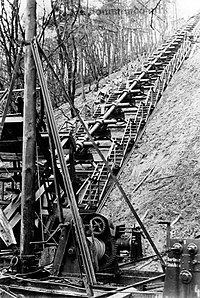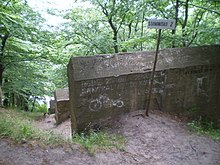Meriam V-3
V-3 (Jerman: Vergeltungswaffe 3, "Senjata Pembalasan 3") adalah sebuah meriam besar Jerman dalam Perang Dunia II yang beroperasi pada prinsip berbilang-cas dimana cas pendorong sekunder dilepaskan untuk menambah halaju pada projektil.
| Hochdruckpumpe ("pam bertekanan tinggi")[1] | |
|---|---|
 Prototaip meriam V-3 di Laatzig, Jerman (sekarang Poland) pada tahun 1942. | |
| Jenis | Artileri |
| Tempat asal | Jerman Nazi |
| Sejarah perkhidmatan | |
| Dalam perkhidmatan | 1944 – 1945 |
| Digunakan oleh | Jerman Nazi |
| Perang | Perang Dunia II |
| Sejarah pengeluaran | |
| Pengeluar | Krupp[2] |
| Spesifikasi | |
| Panjang | 130 m (430 ka)[3] |
| Shel | Peluru meriam 140 kilogram (310 lb) |
| Kaliber | Kaliber 150 milimeter (5.9 in) |
| Ketinggian | tetap |
| Rentas | tetap |
| Kadar tembakan | 300 peluru sejam (projected) |
| Halaju muncung | 1,500 metres per saat (4,900 ft/s) |
| Jarak tembakan maksimum | 165 km |

Senjata ini dirancang penggunaannya untuk mengebom London dari dua bunker besar di wilayah Pas-de-Calais utara Perancis, tetapi ia tidak dapat digunakan kerana di bom pihak Bersekutu sebelum siap dibina. Dua meriam serupa digunakan untuk mengebom Luxembourg dari Disember 1944 hingga Februari 1945.
Meriam V-3 juga dikenali sebagai Hochdruckpumpe ("Pam Bertekanan Tinggi," singkatan HDP), adalah nama kod yang bertujuan untuk menyembunyikan maksud sebenar projek itu. Ia juga dikenali sebagai Fleißiges Lieschen ("Busy Lizzie").[4]
Gambaran sunting
Meriam itu menggunakan cas pelbagai propelan yang dipasang sepanjang laras meriam dan tepat waktunya untuk menyalakan api sebaik saja projektil melintasinya untuk memberikan dorongan tambahan. Penggalak (booster) roket bahan api pepejal digunakan sebagai ganti cas letupan kerana kesesuaian mereka yang lebih besar dan mudah digunakan. Ia disusun dalam pasangan simetri disepanjang laras meriam, bersudut menaik untuk melepaskan bedilannya pada pangkal projektil sewaktu ia dilintasi. Susunan ini melahirkan nama kod Jerman Tausendfüßler ("lipan"). Laras dan kebuk sampingan direka sebagai bahagian yang sama untuk mempermudahkan hasil dan membolehkan bahagian yang rosak digantikan. Keseluruhan meriam akan menggunakan pelbagai bahagian tersebut yang digerakkan bersama. Meriam laras licin (smoothbore) membedil peluru bersirip stabil yang bergantung pada tenaga aerodinamik dan bukannya tenaga giroskopik untuk mencegah jatuh kebawah (berbeza dari senjata rifel konvensional yang menyebabkan projektil berputar); ini menghasilkan pekali seret yang lebih rendah.[5]
Lihat juga sunting
Rujukan dan nota sunting
Nota
Citations
- ^ Thompson, Peter (1999). The V-3 Pump Gun. London: ISO Publications.
- ^ Henshall 1985, halaman 61
- ^ "Fortress de Mimoyecques". theotherside.co.uk. Diarkibkan daripada yang asal pada 2018-08-28. Dicapai pada 24 December 2007. (bottom of page)
- ^ "The V3 weapon system (HDP), "High pressure pump" or "Centipede"". Current museum specials & news. Diarkibkan daripada yang asal pada 2006-08-22. Dicapai pada 24 December 2007. (bottom of page)
- ^ "V-3". www.astronautix.com. Astronautix. Dicapai pada 11 June 2008.
Bibliografi
- Henshall, Philip (1985). Hitler's Rocket Sites. Philip Hale. ISBN 0-7090-2021-X.CS1 maint: ref=harv (link)
- Irving, David (1964). The Mare's Nest (PDF). London: William Kimber and Co. ISBN 978-1-872197-22-7.CS1 maint: ref=harv (link)
- Wood, Paul; Ford, Roger (2000). Germany's Secret Weapons in World War II. Zenith Imprint. m/s. 117–19. ISBN 0-7603-0847-0.CS1 maint: ref=harv (link)
- Zaloga, Steven J.; Johnson, Hugh; Taylor, Chris (2008). German V-Weapon Sites 1943-45. Oxford: Osprey Publishing. ISBN 978-1-84603-247-9.CS1 maint: ref=harv (link)
- Ginisty, Paul (2 March 1884). "Un nouveau cannon" [A new cannon]. L'Actualité militaire illustrée (dalam bahasa French) (6). Dicapai pada 29 June 2011.
Ce canon fût présenté (...) en 1860
CS1 maint: unrecognized language (link) CS1 maint: ref=harv (link) - L'artillerie à l'exposition de 1878. Paris: Berger-Levrault. 1879. Dicapai pada 29 June 2011.
- Birnie, Rogers (1907). "The multicharge gun". Gun making in the United States. Washington: Government printing office. Dicapai pada 28 June 2011.CS1 maint: ref=harv (link)
- Haskell, James Richard (1907). "Discussion". Dalam Birnie, Rogers (penyunting). Gun making in the United States. Washington: Government printing office. m/s. 121–124. Dicapai pada 28 June 2011.
- "The Lyman Accelerator Gun". Van Nostrand's eclectic engineering magazine. 3. D. Van Nostrand. 1870. m/s. 658–659.
Some time back we referred to the construction of the gun known as the accelerator in which a series of chambers were arranged at the side of the bore for containing charges of powder which exploded in succession as the projectile moved along it towards the muzzle until the combination of the charges exerted their full force upon the base of the shot to throw or propel it. The gun tried was of small calibre about 4 inci (100 mm) in diameter and this succeeded beyond the expectations of the company who were present to witness the trial. The success of the small one led the gentlemen interested in its production for field or battery purposes to endeavor to have one of a large size cast. Of course many difficulties had to be overcome before they could venture to make the world acquainted with the fact that a large one was in hand but after several failures mainly due to unforeseen circumstances they have had one cast weighing 10,175 paun (4,615 kg) and measuring 11 kaki 6 inci (3.51 m) in length. This gun was tried in the United States a few miles below Reading Pennsylvania on the old proving ground.
CS1 maint: ref=harv (link) - Bull, Stephen (2004). "V3". Encyclopedia of military technology and innovation. Westport, Conn: Greenwood Press. m/s. 282. ISBN 978-1-57356-557-8.CS1 maint: ref=harv (link)
- "Warfare's new weapon; casting the first of Lyman-Haskell cannon". The New York Times. 25 October 1881.
The first large cannon constructed on the accelerating or multi-charge principle and to be known as the Lyman-Haskell gun was casted today at the foundry of the Reading Iron Works.
- Lyman Holley, Alexander (1865). A treatise on ordnance and armor. D. Van Mostrand. m/s. 885–886.CS1 maint: ref=harv (link)
- Porezag, Karsten (1997). Geheime Kommandosache: Geschichte Der "V-Waffen" Und Geheimen Militaraktionen Des Zweiten Weltkrieges an Lahn, Dill Und Im Westerwald. Verlag Wetzlardruck. ISBN 3-926617-20-9.CS1 maint: ref=harv (link)
- United States Army — Ordnance Dept (1884). Report of the Chief of Ordnance to the Secretary of War. Government Press Office.CS1 maint: ref=harv (link)
- Pallud, Jean-Paul (2003). "Le Bunker de Mimoyecques — Hochdrukpumpe". 39/45 Magazine (dalam bahasa French). 197: 44–57. ISSN 0761-7348.CS1 maint: unrecognized language (link) CS1 maint: ref=harv (link)
- Hogg, Ian V. (2002). German artillery of World War II. London: Greenhill. ISBN 185367480X.CS1 maint: ref=harv (link)
Pautan luar sunting
- Kategori berkenaan Meriam V-3 di Wikimedia Commons
- Diagram of Mimoyecques site
- Various photos